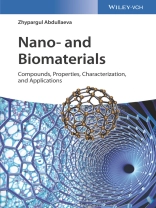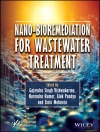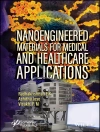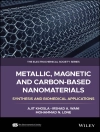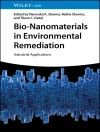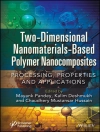A comprehensive introduction to nano- and biomaterials shining light on the different research disciplines from various perspectives.
The straightforward and well-structured concept is designed to cater for entrants as well as experienced researchers in the field of nanotechnology. The initial chapters introduce nanomaterials, their classification and synthesis techniques, while subsequent chapters discuss the various characterization tools as well as mechanical properties and their applications in biotechnological and biomedical fields. Further understanding of the topic is supported by case studies used for practical purposes. The book concludes with a look at future technology advances.
With its explanation of a wide variety of materials, this is an essential reference for chemists, physicists, materials scientists and biomedical engineers.
Содержание
Preface xi
1 Introduction into Nano- and Biomaterials 1
1.1 Definition of Nano- and Biomaterials 1
1.2 History of Nano- and Biomaterials Application 1
1.3 Methods for Preparing of Nanomaterials 2
1.3.1 Mechanical Dispersion Methods for Nanomaterial Synthesis 2
1.3.2 Intensive Plastic Deformation Methods for Nanomaterial Synthesis 5
1.3.3 Obtaining of Nanomaterials by Mechanical Interaction of Various Mediums 8
1.3.4 Physical Dispersion Methods for Nanomaterials Preparation 9
1.3.5 Preparation of Nanomaterials by Evaporation–Condensation Method 10
1.3.6 Obtaining of Nanomaterials by Vacuum-Sublimation Technology 13
1.3.7 Obtaining of Nanomaterials by Using Solid Phase Transformations 14
1.3.8 Chemical Dispersion Methods for Nanomaterial Preparation 14
1.3.9 Obtaining of Nanomaterials by Using Chemical Reactions 15
1.3.10 Preparation of Nanomaterials by Electrochemical Methods 20
1.3.11 Preparation of Nanomaterials by Combinations of Physical and Chemical Transformations 21
1.4 Main Achievements in Nanotechnology 22
Case Study 1: Synthesis of Nanoparticles and Environmental Safety Considerations 22
Case Study 2: Property Control of Nanomaterials by Setting Experimental Conditions during Synthesis 23
Control Questions: 23
References 24
Further Reading 25
2 Classification of Nanomaterials 27
2.1 Dispersive Systems and Their Classifications 27
2.1.1 Classification of Dispersive Systems According to their Aggregation States 27
2.1.2 Classification of Dispersive Systems According to Size 28
2.1.3 Classification of Dispersive Systems According to Dimension 31
2.2 Fullerenes 32
2.2.1 History of Fullerenes 34
2.2.2 Tetrahedral Fullerenes 34
2.2.3 Icosahedral Fullerenes 42
2.2.4 Physical Properties of Fullerenes 47
2.3 Carbon Nanotubes 49
2.3.1 Types and Classification of Carbon Nanotubes 49
2.3.2 Mechanical Properties and Physical Parameters of Carbon Nanotubes 52
Case Study 1: Comparison of Structural Characteristics between Carbon Nanotubes and Fullerenes 54
Control Questions 54
References 55
Further Reading 56
Online Sources 56
3 Nanocomposite Materials and Their Physical Property Features 57
3.1 Nanocomposite Materials 57
3.2 Size Dependence as Nanomaterial Property 57
3.3 Thermodynamical Features of Nanomaterials 58
3.4 Phase Equilibrium Changes in Nano-sized Systems 60
3.5 Melting Temperature Changes in Nanomaterials 61
3.5.1 Polymorphic Characteristic Changes in Nanosystems 61
3.6 Structure of Nano-sized Materials 62
3.7 Crystal Lattice Defects in Nanomaterials 65
3.8 Microdistorsions of Crystal Lattice in Nanomaterials 66
3.9 Consolidation of Nano-sized Powders 68
Case Study 1: Applications of Composite Nanomaterials Due to Their Improved Mechanical Properties 74
Control Questions 75
References 76
Further Reading 76
Online Source 77
4 Mechanical Characteristics of Dispersive Systems 79
4.1 Dispersion Characteristics of Nanomaterials 79
4.1.1 Specific Surface Area 79
4.1.2 Size Distribution in Nanomaterials 80
4.1.3 Surface, Boundaries, and Morphology of Nanomaterials 89
4.1.4 Grain Boundaries in Nanomaterials 91
4.1.5 Morphology of Nanodisperse Particles 92
4.2 Electrical Properties of Nanomaterials 95
4.2.1 Change in Length of Electron Free Path in Nanomaterials 95
4.3 Electrical Conductivity in Nanomaterials 97
4.4 Electron Work Function in Nanomediums 99
4.5 Superconductivity Phenomenon in Nanomaterials 101
Case Study 1: Surfactant Effects on Dispersion Characteristics of Copper-Based Nanomaterials 105
Case Study 2: Applications of Superconducting Nanomaterials 105
Control Questions 106
References 106
Further Reading 106
5 Physical Properties of Nanomaterials: Graphene 109
5.1 Ferromagnetic Characteristics of Nanomaterials 109
5.1.1 Substance in Single-Domain Condition 109
5.1.2 Superparamagnetism in Nanoparticles 111
5.1.3 Size Dependence on Coercive Force 112
5.1.4 Size Dependence on Saturation Magnetization 114
5.1.5 Size Dependence on Curie Temperature 115
5.2 Thermal Property Features in Nanomaterials 115
5.2.1 Size Dependence on Heat Conductivity 116
5.2.2 Heat Conductivity of Crystal Lattice in Nanomaterials 120
5.2.3 Debye Temperature in Nanomaterials 121
5.3 Optical Characteristics of Nanomediums 122
5.3.1 Light Scattering Features of Tiny Particles 123
5.3.2 Extinction by Dielectric Nanoparticles 125
5.3.3 Extinction in Metallic Nanoparticles 128
5.3.4 Influence of Morphology and Polydispersity on Optical Properties of Nanomaterials 131
5.4 Diffusion in Nanomaterials 133
5.4.1 Diffusion in Nanopowders 133
5.5 Graphene 136
5.5.1 Structure of Graphene 137
5.5.2 Electronic Properties of Graphene 138
5.5.3 Topology of Hexagonal Lattice 138
5.5.4 Physical Properties and Ionization Potential of Graphene 139
5.5.5 Approaches in Graphene Synthesis 141
5.5.6 Characterizations of Graphene 142
5.5.7 Applications of Graphene 145
Case Study 1: Structural Features of Graphene, Lattice Directions, Edge Location, Crystal Structure, and Energy in Reciprocal Space 145
Control Questions 147
References 148
Further Reading 149
6 Chemical Properties and Mechanical Characteristics of Nanomaterial Characterization Tools in Nanotechnology 151
6.1 Chemical Properties of Nanomaterials 151
6.1.1 Size Effects in Chemical Processes 151
6.1.2 Oxidation Processes in Nanomediums 153
6.1.3 Spontaneous Combustion and Pyrophoricity of Nanomediums 157
6.1.4 Catalysis Involving Nanomaterials 160
6.2 Mechanical Characteristics of Nanomaterials 163
6.2.1 Hardness, Strength, and Plasticity in Nanomaterials 163
6.2.2 Superplasticity Phenomenon in Nanomaterials 170
6.3 Concept Map of Characterization Tools in Nanotechnology 172
6.4 Diffraction Methods for Nanomaterial Characterization 173
6.5 Microscopical Characterization of Nanomaterials 174
6.5.1 TEM Characterization of Nanomaterials 174
6.5.2 HRTEM Characterization of Nanomaterials 177
6.5.3 AFM Characterization of Nanomaterials 177
6.5.4 SEM Characterization of Nanomaterials 178
6.6 Spectroscopical Characterization of Nanomaterials 181
6.6.1 FT-IR Spectroscopy of Nanomaterials 181
6.6.2 X-ray Photoelectron Spectroscopy of Nanomaterials 182
Case Study 1: Oxidation of Fe Nanoparticles 182
Case Study 2: Microscopical Characterization of Nanomaterials and Sample Preparation 183
Case Study 3: Nanomaterials Strength 184
Control Questions 185
References 185
Further Reading 187
Online Sources 187
7 Introduction to Biomaterials 189
7.1 Biomaterials: Subject, Purpose, and Problems 189
7.1.1 Current Goals of Biomaterials Field 189
7.2 General Requirements for Biomaterials 190
7.3 Biomaterials in Body Systems 191
7.4 Types and Classification of Biomaterials 192
7.4.1 Metallic Biomaterials 193
7.4.2 Composite Biomaterials 199
7.4.3 Nanostructured Ca P Composites 200
Case Study 1: Mechanical Properties of Bone Cements and Tissue Interface Formation after Implantation 203
Control Questions 204
References 205
Further Reading 207
8 Properties of Biomaterials 209
8.1 Mechanical Properties of Biomaterials 209
8.1.1 Mechanical Properties of Biomaterials 209
8.1.2 Titanium Alloy with Self-Adjustable Young’s Modulus 211
8.1.3 Wear Resistance of Biomaterials Used in the Living Body 212
8.2 Biological Properties of Biomaterials 215
8.2.1 In Vivo Tissue Biocompatibility 215
8.3 Chemical Properties of Biomaterials 220
8.3.1 Ceramic Biomaterials 222
8.3.2 Polymer Biomaterials 230
Case Study 1: Polymeric Biomaterials Used in Load-Bearing Medical Devices 235
Control Questions 236
References 237
Further Reading 238
9 Implants and Artificial Organs 239
9.1 Implants 239
9.2 Types of Implants 239
9.2.1 Intraocular Lenses 239
9.2.2 Cochlear Implants 241
9.2.3 Brain Implants 242
9.2.4 Heart Implants 243
9.2.5 Joint Implants 246
9.2.6 Other Organ Replacement Implants 247
9.3 Processes between Living Tissue and Implant Interface 249
Case Study 1: Iris-Fixated Phakic Intraocular Lens Implantation after Retinal Detachment Surgery: Long-Term Clinical Results 252
Case Study 2: Cardiac Pacing Systems and Implantable Cardiac Defibrillators (ICDs): A Radiological Perspective of Equipment, Anatomy, and Complications 254
Control Questions 255
References 256
Further Reading 258
10 Tissue Engineering, Scaffolds, and 3D Bioprinting 259
10.1 Definition of Tissue Engineering 259
10.1.1 Biomaterials Used for Tissue Engineering 259
10.1.2 Principles of Tissue Engineering 260
10.1.3 Components of Tissue Engineered Constructs 260
10.2 Scaffolds and Scaffolding 262
10.2.1 Scaffolds for Bone Tissue Engineering 262
10.2.2 Tissue Engineering of Heart Valves 264
10.3 3D Bioprinting 266
10.4 Foreign Body Reaction 271
10.4.1 Inflammatory Response Following Material Implantation 273
10.4.2 Monocytes, Macrophages, and Foreign Body Giant Cells 274
10.5 Wound Healing 275
Case Study 1: Bioactive Glass and Glass-Ceramic Scaffolds for Bone Tissue Engineering 275
Case Study 2: Regulatory Considerations in the Design and Manufacturing of Implantable 3D Printed Medical Devices 276
Control Questions 279
References 279
Further Reading 282
Index 283
Об авторе
Zhypargul Abdullaeva is Assistant Professor in the Department of Materials Science and Engineering at Kumamoto University in Japan. She has graduated with a Ph D degree from Kumamoto University. She worked on the syntheses of carbon nanomaterials and their characterizations. She has obtained a high standard of teaching skills as she taught at various universities and at a variety of levels. Also she has contributed to improve teaching methods.
Professor Abdullaeva has authored a number of scientific publications and has received the gold, silver and bronze Diploma Awards in the Chemistry Olympiads. She is also a member of the Japanese Ceramics Society, European Society of Biomaterials, and the Materials Research Society.
